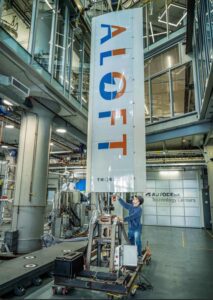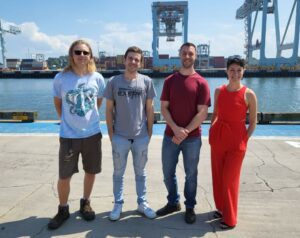Aloft Systems: Tackling Maritime Emissions with Modern Sail Technology
Autodesk Research Residency Program team Aloft Systems is charting a new course in the maritime industry with an innovative approach to reducing emissions through modern sail technology. Aloft is working to revolutionize the shipping industry by harnessing the power of wind energy for propulsion, reducing carbon emissions without the need for switching fuels, infrastructure overhauls, or operational slowdowns. At AU 2024, Aloft will showcase their sail technology and engage participants with interactive demonstrations.
Rigid Wing Sail Technology: A Blend of Tradition and Modernity
Miles Keeney-Ritchie, Founder and Head of Aloft, is driven by a passion for renewable energy and a background in robotics and automation. “I actually wanted to design wind turbine blades or something else having to do with renewable energy,” recalled Keeney-Ritchie.
However, his career took an unexpected turn when he discovered mechatronics in grad school. One class was all it took to hook him, leading him to work in process automation and robotics companies. This new path took him around the globe, setting up manufacturing lines and solving complex problems, but eventually, it brought him back to his original passion for renewable energy.
Leveraging this expertise, he founded Aloft to address the significant environmental impact of the maritime sector. Cargo ships, which transport 90% of global goods, emit around a billion tons of emissions annually. This stark reality propelled Aloft’s mission to develop rigid wing sail technology designed to reduce fuel consumption and emissions. Aloft’s technology merges ancient wind propulsion methods with modern robotics and automation. Their rigid wing sails can be mounted on various vessels, optimizing wind use without increasing crew labor. This approach not only cuts down on emissions but also reduces operational costs for ship owners, presenting a sustainable and economically viable solution to the industry.
Reflecting on their mission, Keeney-Ritchie said, “The maritime industry is critical to our collective global economy and it’s also a huge polluter. We started digging into it and developing our version of rigid wing sail technology that can be mounted on any vessel.”
Key to Aloft’s development has been its involvement in the Autodesk Research Residency Program at the Autodesk Technology Center in Boston. The residency provided Aloft with access to best-in-class fabrication equipment and a collaborative environment. Autodesk software, particularly Fusion, was instrumental in streamlining Aloft’s design and manufacturing processes. These tools enabled the team to handle complex models and collaborate effectively despite being a distributed team.
“We used almost every piece of equipment in the tech center to build our prototype,” said Keeney-Ritchie, emphasizing the importance of having the right tools and community support. “Not a week that goes by where we don’t ask somebody about their area of expertise and get advice on something that we’re doing.”
Future Plans: Scaling Up for a Sustainable Maritime Future
Looking ahead, Aloft’s plans are ambitious yet grounded in sustainability and scalability. They are currently ramping up work to build a half-scale pilot unit to be tested on a vessel for a year, which will help them validate their design in various wind and environmental conditions. “After that, we’re off to the races building a full-size unit and hopefully many, many more,” said Keeney-Ritchie. “Our long-term vision includes scaling up production to thousands of units annually, aiming to make a significant dent in global maritime emissions while fostering job creation and sustainable industry practices.”
At AU, Aloft will showcase a prototype of their sail technology. Attendees will have the opportunity to interact with a prototype of their sail and even play a game designed to simulate controlling the sail and optimizing thrust. “We’ve developed a little game where, if you stop by, you can control the sail and attempt to get the most impact on the vessel by adjusting it to the wind, just like our control system would,” explained Keeney-Ritchie.
If you’re headed to AU, visit Aloft and test your sailing skills!
- Stay up-to-date on Aloft’s work
- Learn more about the Autodesk Research Residency Program
Get in touch
Have we piqued your interest? Get in touch if you’d like to learn more about Autodesk Research, our projects, people, and potential collaboration opportunities
Contact us